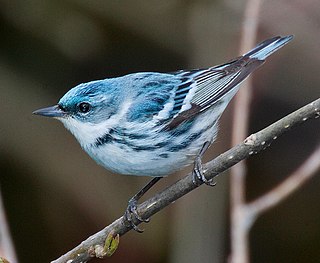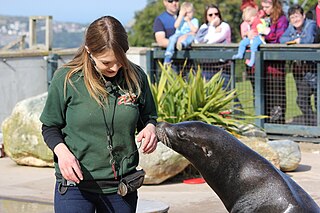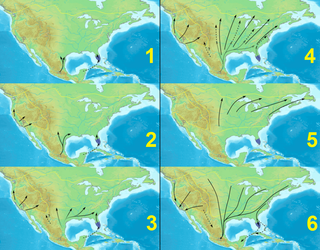Related Research Articles

Bird migration is the regular seasonal movement, often north and south, along a flyway, between breeding and wintering grounds. Many species of bird migrate. Migration carries high costs in predation and mortality, including from hunting by humans, and is driven primarily by the availability of food. It occurs mainly in the northern hemisphere, where birds are funnelled onto specific routes by natural barriers such as the Mediterranean Sea or the Caribbean Sea.

The National Zoological Park, commonly known as the National Zoo, is one of the oldest zoos in the United States. It is part of the Smithsonian Institution and does not charge admission. Founded in 1889, its mission is to "provide engaging experiences with animals and create and share knowledge to save wildlife and habitats".

The northern bald ibis, hermit ibis, or waldrapp is a migratory bird found in barren, semi-desert or rocky habitats, often close to running water. This 70–80 cm (28–31 in) glossy black ibis, which, unlike many members of the ibis family, is non-wading, has an unfeathered red face and head, and a long, curved red bill. It breeds colonially on coastal or mountain cliff ledges, where it typically lays two to three eggs in a stick nest, and feeds on lizards, insects, and other small animals.

The long-billed curlew is a large North American shorebird of the family Scolopacidae. This species was also called "sicklebird" and the "candlestick bird". The species breeds in central and western North America, migrating southward and coastward for the winter.

The harpy eagle is a neotropical species of eagle. It is also called the American harpy eagle to distinguish it from the Papuan eagle, which is sometimes known as the New Guinea harpy eagle or Papuan harpy eagle. It is the largest and most powerful raptor found throughout its range, and among the largest extant species of eagles in the world. It usually inhabits tropical lowland rainforests in the upper (emergent) canopy layer. Destruction of its natural habitat has caused it to vanish from many parts of its former range, and it is nearly extirpated from much of Central America. In Brazil, the harpy eagle is also known as royal-hawk.

The whooping crane is an endangered crane species, native to North America, named for its “whooping” calls. Along with the sandhill crane, it is one of only two crane species native to North America, and it is also the tallest North American bird species. The whooping crane's lifespan is estimated to be 22-24 years in the wild. After being pushed to the brink of extinction, due to unregulated hunting and loss of habitat, and just 21 wild cranes remaining by 1941, conservation efforts would lead to a partial recovery. The total number of cranes in the surviving migratory population, plus three reintroduced flocks and in-captivity, only slightly exceeds 800 birds as of 2020.

The American redstart is a New World warbler. It is unrelated to the Old World (common) redstart.

The cerulean warbler is a small songbird in the family Parulidae. It is a long-distance migrant, breeding in eastern North American hardwood forests. In the non-breeding season, it winters on the eastern slope of the Andes in South America, preferring subtropical forests.

The Madras Crocodile Bank Trust and Centre for Herpetology (MCBT) is a reptile zoo and herpetology research station, located 40 kilometres (25 mi) south of the city of Chennai, in state of Tamil Nadu, India. The centre is both a registered trust and a recognized zoo under the Wildlife (Protection) Act, 1972 and comes under the purview of the Central Zoo Authority, Ministry of Environment, Forest and Climate Change, Government of India. It was established with the aim of saving three Indian endangered species of crocodile—the marsh or mugger crocodile, the saltwater crocodile, and the gharial, which at the time of founding of the trust were all nearing extinction.

The Wildlife Conservation Society (WCS) is a 501(c)(3) non-governmental organization headquartered at the Bronx Zoo in New York City, that aims to conserve the world's largest wild places in 14 priority regions. Founded in 1895 as the New York Zoological Society (NYZS), the organization is now led by President and CEO, Monica P. Medina, who replaced long time President and CEO Cristián Samper in 2023. WCS manages four New York City wildlife parks in addition to the Bronx Zoo: the Central Park Zoo, New York Aquarium, Prospect Park Zoo and Queens Zoo. Together these parks receive 4 million visitors per year. All of the New York City facilities are accredited by the Association of Zoos and Aquariums (AZA).

The Smithsonian Conservation Biology Institute (SCBI) is a unit of the Smithsonian Institution located on a 3,200-acre (13 km2) campus located just outside the town of Front Royal, Virginia. An extension of the National Zoo in Washington, D.C., the SCBI has played a leading role in the fields of veterinary medicine, reproductive physiology and conservation biology since its founding in 1974.

Captive breeding, also known as captive propagation, is the process of keeping plants or animals in controlled environments, such as wildlife reserves, zoos, botanic gardens, and other conservation facilities. It is sometimes employed to help species that are being threatened by the effects of human activities such as climate change, habitat loss, fragmentation, overhunting or fishing, pollution, predation, disease, and parasitism.

A zoo is a facility in which animals are kept within enclosures for public exhibition and often bred for conservation purposes.

Shade-grown coffee is a form of the crop produced from coffee plants grown under a canopy of trees. A canopy of assorted types of shade trees is created to cultivate shade-grown coffee. Because it incorporates principles of natural ecology to promote natural ecological relationships, shade-grown coffee can be considered an offshoot of agricultural permaculture or agroforestry. The resulting coffee can be marketed as "shade-grown".
Bird Day is the name of several holidays celebrating birds. Various countries observe such a holiday on various dates.

The Patuxent Research Refuge is a National Wildlife Refuge in Prince George's County, Maryland, United States, established in 1936 by executive order of President Franklin D. Roosevelt. It is the only National Wildlife Refuge in the country established to support wildlife research. With land surrounding the Patuxent and Little Patuxent Rivers between Washington, D.C., and Baltimore, Maryland, the refuge has grown from the original 2,670 acres (10.8 km2) to its present size of over 12,800 acres (52 km2) and encompasses land formerly managed by the Departments of Agriculture and Defense. Throughout decades of change, Patuxent's mission of conserving and protecting the nation's wildlife and habitat through research and wildlife management techniques has remained virtually unchanged.
Cerulean Warbler Bird Reserve, known in Spanish as Reserva Natural de las Aves Reinita Cielo Azul, is a nature reserve near Bucaramanga in central Colombia. The reserve is set among oak forest on the eastern slopes of the Magdalena River. It measures 545 acres (221 ha) and adjoins the Yariguíes National Park.

Monarch butterfly migration is the phenomenon, mainly across North America, where the subspecies Danaus plexippus plexippus migrates each summer and autumn to and from overwintering sites on the West Coast of California or mountainous sites in Central Mexico. Other subspecies perform minor migrations or none at all. This massive movement of butterflies has been called "one of the most spectacular natural phenomena in the world".
Climate change in Mexico is expected to have widespread impacts on Mexico: with significant decreases in precipitation and increases in temperatures. This will put pressure on the economy, people and the biodiversity of many parts of the country, which have largely arid or hot climates. Already climate change has impacted agriculture, biodiversity, farmer livelihoods, and migration, as well as "water, health, air pollution, traffic disruption from floods, [and] housing vulnerability to landslides."

Sara Hallager is an American biologist in avian management and husbandry, specializing in the care and conservation of flamingos and kori bustards. She is curator of birds at the Smithsonian National Zoo.
References
- ↑ "Smithsonian Conservation Biology Institute - National Zoo | FONZ". Smithsonian. Retrieved 26 September 2012.
- ↑ Chong, Jia-Rui (2007-05-17). "Study tallies West Nile's toll on continent's birds". Los Angeles Times . Retrieved 2009-07-14.
- ↑ Kaplan, Janice L. (2003-05-02). "Research Program Is for the Birds". washingtonpost.com. Retrieved 2009-07-14.
- ↑ "Study: Mangrove Animals Risk Extinction". www.upi.com. Retrieved 2009-07-14.
- ↑ "Population Connectivity". www.newsdesk.umd.edu. Retrieved 2009-07-14.
- 1 2 Fears, Darryl (2020-05-22). "Amid the pandemic, people are paying more attention to tweets. And not the Twitter kind". Washington Post. ISSN 0190-8286 . Retrieved 2023-01-07.
- ↑ "Think Before You Drink". www.washingtonpost.com. 2003-02-28. Retrieved 2009-07-14.
- ↑ "Wake Up and Smell the Bird-Friendly, Shade-Grown Coffee". www.sfgate.com/chronicle/. 1999-07-11. Retrieved 2009-07-14.
- ↑ "Bird Friendly coffee". www.birdwatchersdigest.com. Archived from the original on March 16, 2009. Retrieved 2009-07-14.
{{cite web}}: CS1 maint: unfit URL (link) - ↑ "Bird Friendly certification". www.ethicalcoffee.net. Retrieved 2009-07-14.
- ↑ "Bird Day History". Environment for the Americas. Retrieved 28 September 2012.
- ↑ "Neighborhood Nestwatch". wamu.org. Retrieved 2009-07-14.
- ↑ Young, Lauren (2013-06-13). "'Bird Doctors' Come to Lake Anne Elementary". www.connectionnewspapers.com. Retrieved 2023-01-07.
- ↑ "Migratory Birds Project". www.hmerida.com. Retrieved 2009-07-14.
- ↑ "Bridging the Americas". Smithsonian. Retrieved 29 September 2012.